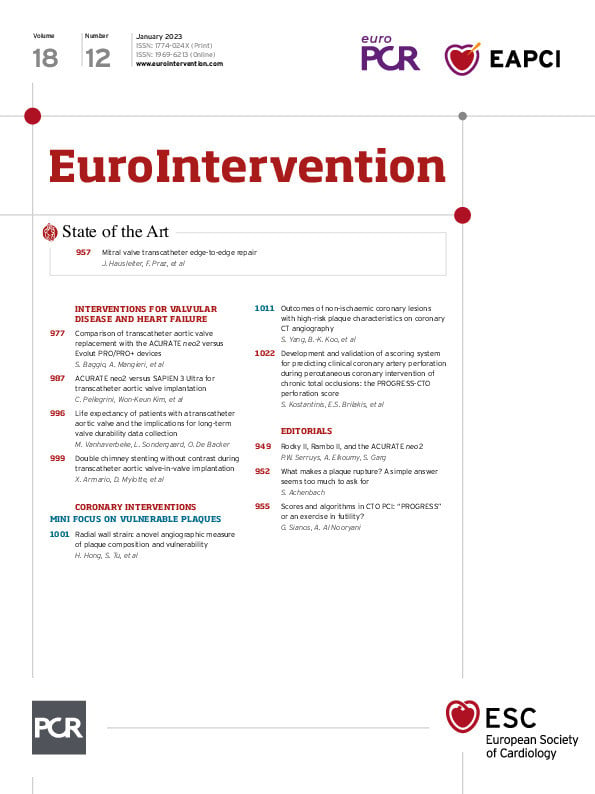Chronic total occlusions (CTO) are a common anatomical entity in complex coronary artery disease. Treatment options over the last two decades have been revolutionised by an evolution in techniques and technology. Treatment algorithms intended to guide new operators through structured procedural planning and practice have been created. Many of these proposed algorithms reflect local practices around the globe. Global guiding principles and a global algorithm1 have been published very recently, which is indicative that practices are gradually becoming standardised and harmonised globally. Not all CTO scores are the same. The J-CTO score was developed in 2011 to predict the possibility of successful wire crossing within 30 min using antegrade techniques. Since then, many scores have been proposed (4 angiographic and 3 computed tomography [CT]-based) indicating an evolving field but also reflecting that local practices strongly influence both the success and complication parameters2. The scores are rather complementary if interpreted and adapted properly to individual practice patterns.
CTO proponents felt there was an unmet need due to inferior success rates compared to non-occlusive percutaneous coronary intervention (PCI). This was successfully addressed with substantial improvements in success rates, reaching 90% in expert hands. Beyond the technical aspects, this unmet need was and is still challenged by many, based on a failure to show any prognostic survival benefit in randomised trials compared to optimal medical therapy3, as well as the higher rate of complications4 and the cost of these procedures5. Symptomatic improvement is accepted as the main benefit of opening CTO but this is not a strong argument for many, and that is reflected in the downgrading of CTO PCI indications in the US guidelines.
Addressing complications is a major challenge in CTO PCI. In stable coronary artery disease, the tolerance for complications is limited, if not zero. Beyond patient safety in what is an already very expensive procedure â almost double compared to non-CTO PCI â complications can add another 30% to the total cost5. Perforations are the most detrimental complication and are also more frequent, ranging from 30-60% of the total incidence of complications in different databases. CTO PCI is the strongest independent predictor of developing coronary artery perforation and is associated with a 7-fold increase in the adjusted risk of such a complication, compared to non-CTO PCI6. Therefore, predicting complications, and especially perforations, is critically important.
In the current issue of EuroIntervention, Kostantinis et al discuss the PROGRESS-CTO perforation score7. It is derived from the well-known and exceptionally well-published PROGRESS-CTO database. It is essentially an extension of the recently proposed score for major adverse cardiovascular events (MACE), ST-elevation myocardial infarction (STEMI), pericardiocentesis and death8, which was a revision of a more general complication score published in 2016 by the same group. The detailing of the perforation is certainly a refinement, although the current report does not add significantly more information when compared to the previously reported pericardiocentesis score.
The OPEN-CLEAN perforation score was also recently proposed9. The two scores have only two parameters in common: age and the degree of calcification. Importantly, the crossing technique, especially the retrograde (RG) technique, which adds 2 points to the PROGRESS-CTO complication score, was not a predictive factor for the OPEN-CLEAN perforation score. As Kostantinis et al note, “These differences in risk model performance across diverse cohorts may reflect differences in practice patterns.” Indeed, in the international PROGRESS-CTO registry, the incidence of the RG technique was 19% and the antegrade dissection and re-entry technique (ADR) 13%, while in OPEN-CTO, which is an American registry, they were 32% and 22%, respectively. In the European ERCTO registry, the RG technique is reported at 30% and ADR at 5%4, clearly depicting a variance of practice among different continents.
In the current report there is a great discrepancy in the perforation rate, ranging from 9.3% to 0% among different centres, most likely reflecting operator experience and centre practice. It is well established that operator experience is related to increased success rates, especially in the most complex CTO. Differences in experience might be related to differences in outcomes, including complications and perforations. Unfortunately, it was not addressed in more detail in the current PROGRESS-CTO perforation score.
There is a difference in the pattern of perforations based on the technique used, with large and distal vessel perforations representing 66%, while 18% are epicardial and septal collateral perforations. Channel perforations are only relevant to retrograde techniques. In the current proposal, retrograde techniques are generally profiled as “dangerous”, and this might prohibit operators from adopting them and thus potentially providing patients with inferior success rates. The proposition in the discussion to “consider investment techniques as a possible alternative instead of aggressive crossing attempts” is, in our view, the wrong direction. Are retrograde techniques a risk factor for large and distal vessel perforations? And if so, are they more or less risky compared to the ADR and antegrade wiring (AW) techniques? Which are the risk factors for septal and epicardial channel perforations when retrograde techniques are necessary? These are very relevant questions that cannot be answered with the current report. A more pragmatic approach would be to analyse the perforations separately and not lump all types of perforations together. This will provide a better risk assessment for perforation when applying the necessary technique to achieve success.
To come back to the question in the title of this editorial, do scores and algorithms represent progress? Just as practice patterns are ever-evolving, so are scores and algorithms. As practice patterns are always personal, it is important to adopt them critically.
Conflict of interest statement
The authors have no conflicts of interest to declare.

